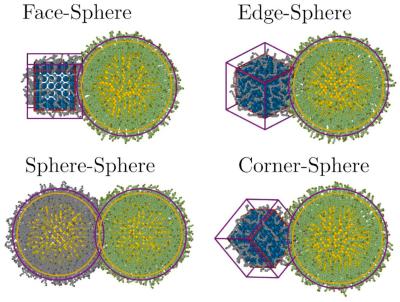Researchers from Ames National Laboratory worked with scientists at the Swiss Federal Institute of Technology in Zürich (ETH Zurich) to understand how to assemble perovskites (that are shaped as nanocubes) with other sphere-shaped nanocrystals.
The scientists used the Expanse supercomputer at the San Diego Supercomputer Center (SDSC) at UC San Diego to identity the general rules that enable the assembly of nanocubes like perovskites with spherical nanoparticles. Ultimately, they conducted a study to assist with the design of future nanoparticle-based materials. Their recent paper provides details on both their results and problems when pairing the perovskites with spherical nanocrystals.
“Nanoscience in general, and nanoparticles in more concrete terms, have the potential to change the world as we know it, by developing materials that vastly surpass the properties of the ones we are using today,” said Ames National Laboratory Physicist Alex Travesset, co-author and professor in the department of physics and astronomy at Iowa State University and associate scientist at Ames Lab. “Advancing our ability to assemble nanoparticles, and perovskites in particular, is a necessary and important step towards accelerating this process of materials discovery—and SDSC resources make this research possible.”
Travesset said using a supercomputer like Expanse is not just about lowering the cost of research efforts, but also the availability was critical, as it is not feasible for each research group to purchase and maintain such infrastructure. He said that Jonas Hallstrom, an undergraduate student at Arizona State University, and Xun Zha, former Iowa State University graduate student, performed most of the work on Expanse. Specifically, Jonas implemented innovative ways to perform and run simulations, and Xun contributed by developing algorithms to analyze the data. Meanwhile, the study’s experimental work was conducted by Maksym Kovalenko and Ihor Cherniukh at ETH Zurich.
“What most excited me about the study was that we were able to demonstrate the detailed verification of the Orbifold Topological Model (OTM)—a model developed in my group to predict the structure of nanoparticle arrangements,” Travesset said. “Also, the technical aspects that were necessary to accurately perform the Expanse simulations were considerable. I was very impressed with the work of our undergraduate colleague Jonas Hallstrom, as the work really exceeds the expectations of a physics undergraduate. He performed a superb job—and I am very excited to see where his career goes, given what he has already accomplished so far.”
For future steps of the overall work, the team has made plans to generalize the OTM to other nanoparticle shapes and refine their methods so that they can compute free energies and more accurately predict experiments and future materials.
